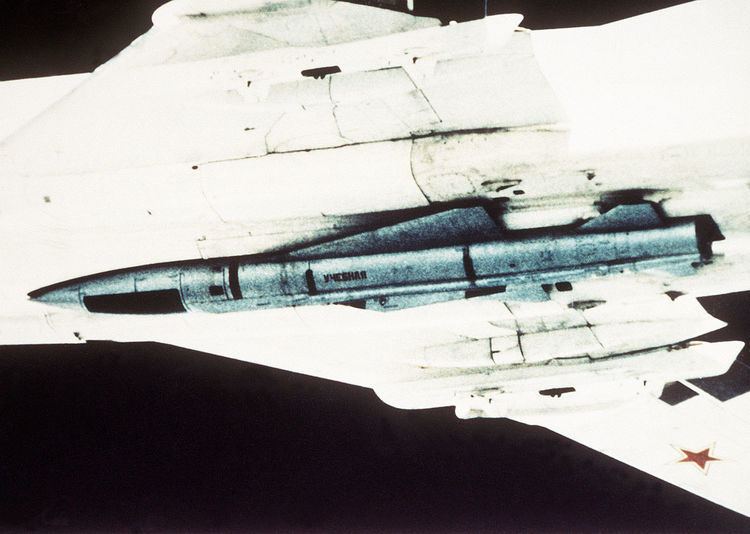Type air-to-surface missile Produced 1962 | Weight 5,820 kg (12,800 lb) | |
 | ||
MKB Raduga's Kh-22 (Russian: Х-22; AS-4 'Kitchen') is a large, long-range anti-ship missile developed by the Soviet Union. It was intended for use against US Navy aircraft carriers and carrier battle groups, with either a conventional or nuclear warhead.
Contents
Development
After analyzing World War II naval battles and encounters in the late 1940s and early 1950s, Soviet military thinkers assessed that the times of large seaborne battles were over, and that stand-off attacks were the way to neutralize and incapacitate large battle groups without having to field a similar force against them. Substituting cruise missiles for air attacks, VVS and AV-MF commanders set about to convert their heavy bombers to raketonosets, or missile carriers, which could be launched against approaching enemy fleets and task forces from coastal or island airfields. The Kh-22 (Complex 22) weapon was developed by the Raduga design bureau and used to arm the Tupolev Tu-22M.
Design
The Kh-22 uses an Isayev liquid-fuel rocket engine, fueled with TG-02 (Tonka-250) and IRFNA (inhibited red fuming nitric acid), giving it a maximum speed of Mach 4.6 and a range of up to 600 km (320 nmi). It can be launched in either high-altitude or low-altitude mode. In high-altitude mode, it climbs to an altitude of 27,000 m (89,000 ft) and makes a high-speed dive into the target, with a terminal speed of about Mach 4.6. In low-altitude mode, it climbs to 12,000 m (39,000 ft) and makes a shallow dive at about Mach 3.5, making the final approach at an altitude under 500 m (1,600 ft). The missile is guided by a gyro-stabilized autopilot in conjunction with a radio altimeter.
Soviet tests revealed that when a shaped charge warhead weighing 1,000 kg (2,200 lb) was used in the missile, the resulting hole measured 5 m (16 ft) in diameter, and was 12 m (40 ft) deep. Soviet Tests showed that a Kh-22MA equipped with 1,000 kg (2,205 lb) RDX warhead and with an approach speed of 800 m/s (Mach 2.4), used against an aircraft carrier, will make a 22 m2 (240 sq ft) diameter hole, and the warhead's cumulative jet will burn through internal ship compartments up to a depth of 12 m.
By August 2016, Russia was finalizing the trials of the Kh-32 cruise missile, a derivative of the Kh-22. Designed for use by the Tu-22M3 bomber, the missile is designed to climb to 40 km (130,000 ft) to the stratosphere after launch, transition to level flight, then perform a steep dive to the target; its combination of speed and flight path makes it virtually invulnerable to interception by ground-based air defenses and fighters. The advanced cruise missile is designed to target enemy ships, radars, and "radio-contrast targets" like bridges, military bases, electric power plants, and others. The Kh-32 has an inertial navigation system and radar homing head, making it independent of GPS/GLONASS navigation satellites. Presumably, it has a range of 1,000 km (620 mi; 540 nmi) and a speed of at least 5,000 km/h (3,100 mph; Mach 4.1).
Operational history
The first service-ready missiles were ready in 1962.
The main launch platform is the Tu-22M 'Backfire'. Russia has also used it on the Тu-22К 'Blinder-B' and Tu-95К22 'Bear-G'.
Variants
Two initial versions were built, the Kh-22 with a large conventional warhead and the Kh-22N, with a 350-1000-kiloton nuclear warhead. In the mid-1970s this was supplemented by the Kh-22P, an anti-radiation missile for the destruction of radar installations. In the 1970s the Kh-22 was upgraded to Kh-22M and Kh-22MA standard, with new attack profiles, somewhat longer range, and a datalink allowing mid-course updates.
